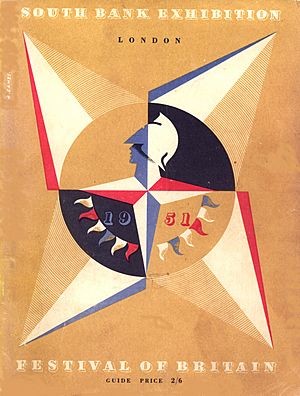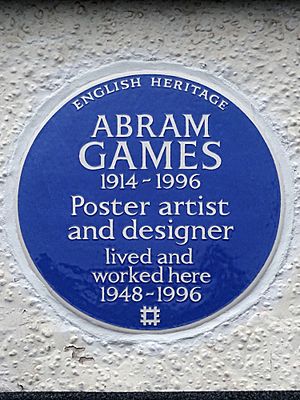Abram Games facts for kids
Quick facts for kids
Abram Games
|
|
|---|---|
| Born |
Abraham Gamse
29 July 1914 Whitechapel, London, England
|
| Died | 27 August 1996 (aged 82) London, England
|
| Education | Saint Martin's School of Art |
| Known for | Graphic design |
| Spouse(s) |
Marianne Salfeld
(m. 1945; |
Abram Games OBE, RDI (29 July 1914 – 27 August 1996) was a famous British graphic designer. He was known for his strong and clear designs. This made him one of the best graphic designers of the 20th century. He believed his posters could make people think and act. His long career, lasting over 60 years, shows us a lot about the history of his time. Some of Britain's most famous images were created by Games. One example is the "Join the ATS" poster from 1941. People called it the "blonde bombshell" poster. His work is known for its "striking colour, bold graphic ideas, and beautifully integrated typography."
Contents
Abram Games' Early Life and Career
Abram Games was born Abraham Gamse in Whitechapel, London. This was on 29 July 1914, just after World War I started. His father, Joseph Gamse, was a photographer from Latvia. His mother, Sarah, was a seamstress. She was born near the border of Russia and Poland. His father moved to Britain in 1904. He changed the family name to Games when Abram was 12 years old.
Games left Hackney Downs School when he was 16. In 1930, he went to Saint Martin's School of Art in London. He didn't like the teaching there and worried about the cost. So, Games left after only two terms. But Games really wanted to be a poster artist. He worked as a "studio boy" for a design company called Askew-Young. This was in London between 1932 and 1936. During this time, he also took night classes to learn drawing. He was fired from this job for playing a prank. He jumped over four chairs!
In 1934, he came second in the Health Council Competition. In 1935, he won a poster competition for the London County Council. From 1936 to 1940, he worked on his own as a freelance poster artist. A magazine called Art and Industry wrote about him in 1937. This led to many important jobs for Games. He worked for the General Post Office, London Transport, and Royal Dutch Shell.
World War Two Poster Designs
When World War Two began, Games joined the British Army. He served until 1941. Then, the Public Relations Department of the War Office asked him to join them. They needed a graphic designer to make a poster for the Royal Armoured Corps. From 1942, Games became the Official War Artist for posters. He created about 100 posters.
Games was given a lot of artistic freedom. This helped him create many striking images. Often, his designs had surreal elements, which means they were dream-like. One of his first designs was a recruitment poster for the Auxiliary Territorial Service. This poster became known as the blonde bombshell. Games wanted to make the ATS look more exciting. But the authorities worried that the glamorous image would make young women join for the "wrong reasons." So, the poster was quickly removed. The new design Games made was even criticized by Winston Churchill for looking too "Soviet."
Other famous posters included Your Talk May Kill Your Comrades (1942). In this poster, a spiral shape came from a soldier's mouth. It turned into a bayonet attacking three of his friends. This showed how gossip could be dangerous. Games used photo techniques he learned from his father in this poster. He also used them in He Talked...They Died (1943). This was part of the Careless Talk campaign. Games also did other work for the War Artists' Advisory Committee.
Later in the war, Churchill ordered one of Games's posters to be removed. This was from an exhibition called Poster Design in Wartime Britain in 1943. The Army Bureau of Current Affairs, ABCA, had asked Games and Frank Newbould to make posters. These were for a series called Your Britain - Fight for It Now. Newbould made pictures of the countryside. Games showed three modern buildings. These buildings were built to help with poverty and sickness. The poster that made Churchill most upset showed the Berthold Lubetkin-designed Finsbury Health Centre. It was shown replacing a ruined building with a sick child. Churchill thought this was unfair to British cities. He ordered the poster to be taken down. Ernest Bevin, the war-time Minister of Labour, also had another poster in the series removed.
Abram Games' Later Career

In 1946, Games went back to working for himself. He worked for many clients like Royal Dutch Shell, the Financial Times, Guinness, British Airways, London Transport, and El Al. He designed stamps for Britain, Ireland, Israel, Jersey, and Portugal. He also designed the logo for the JFS school.
Games also designed book covers for Penguin Books. He created logos for the 1951 Festival of Britain. He won a competition for this in 1948. He also designed the logo for the 1965 Queen's Award to Industry. In 1954, he made the first moving on-screen symbol for BBC Television. He also created large wall paintings called murals.
From 1946 to 1953, Games taught graphic design at London's Royal College of Art. In 1958, he received the OBE. This award was for his great work in graphic design. In 1959, he was named a Royal Designer for Industry (RDI). He also designed the swan tile pattern at Stockwell tube station in the late 1960s.
Games was Jewish and often worked to support Jewish and Israeli groups. He spent time in Israel in the 1950s. There, he designed stamps for the Israeli Post Office. This included stamps for the 1953 Conquest of the Desert exhibition. He also taught a course on designing postage stamps. He designed covers for The Jewish Chronicle and prayer book prints. In 1960, Games designed the poster called Freedom from Hunger. This was for the Food and Agriculture Organization of the United Nations.
Games also designed products. He designed the 1947 Cona vacuum coffee maker. This coffee maker is still made today. He also invented a round vacuum cleaner. In the early 1960s, he designed a portable copying machine for Gestetner. However, this machine was never made.
When creating a poster, Games would draw up to 30 small sketches. Then he would combine two or three of them into the final design. He worked small because he believed if a design "doesn't work an inch high, it will never work." He also used many photographs for ideas.
In 2013, the National Army Museum in London bought a collection of his posters. Each poster was signed by Games and was in perfect condition.
Abram Games' Personal Life

In October 1945, Games married Marianne Salfeld. She was the daughter of German Jewish immigrants. They first lived with her father in Surbiton, Surrey. In 1948, they moved to north London. They lived in the same house until they both passed away. They had three children: Naomi, Daniel, and Sophie.
Marianne died in 1988. Games died in London on 27 August 1996.
Exhibitions of Abram Games' Work
- Abram Games, Graphic Designer (1914–1996): Maximum Meaning, Minimum Means, Design Museum, London, 2003
- Abram Games, Maximum Meaning, Minimum Means, The Minories, Colchester, 2011
- Designing the 20th Century: Life and Work of Abram Games, Jewish Museum London, 2014–2015
- Abram Games - Maximum Meaning Minimum Means, Dick Institute Kilmarnock, East Ayrshire, 2015
- The Art of Persuasion: War time posters by Abram Games, National Army Museum, London: 6 April-24 November 2019
Images for kids
-
Poster by Games advertising tourism for the island of Jersey.




